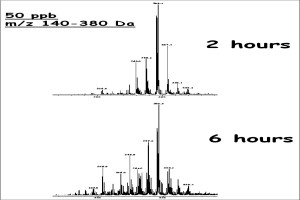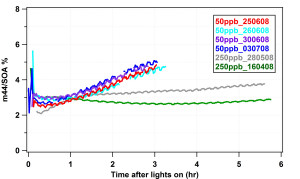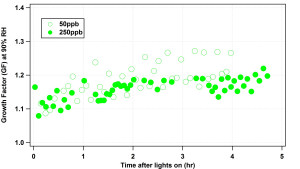The Manchester Aerosol Chamber - Ageing Studies



A selection of compounds covering a wide range of reactivity including isoprene (C5 H8), monoterpenes (isomeric formula C10 H16), sesqiterpenes (isomeric formula C15H24) and oxygenated VOCs have been studied in detail. The chemical composition of the formed SOA was measured on-line using an Aerodyne Time-of-Flight Aerosol Mass Spectrometer (ToF-AMS) and by using a high volume pump and a collapsible chamber, the entire contents of the chamber could be sampled rapidly onto a filter for off-line molecular analyses. Repetitive experiments were carried out and filter samples taken at different experiment times – 2, 4 and 6 hours – allowed the evolution of individual SOA components to be investigated. A hygroscopicity tandem differential mobility analyser (HTDMA) and a cloud condensation nuclei (CCN) counter were used to probe the hygroscopic properties and of the aerosols in the sub- and super-saturated regimes, respectively. A proton transfer mass spectrometer was used to study the evolution of the gas phase oxidation products.
For example, the composition of β-caryophyllene SOA was studied using liquid chromatography coupled to mass spectrometry. Twelve components were identified based on MS2 fragmentation patterns. The SOA composition was found to be much simpler than seen for monoterpenes and no oligomers were found. Experiments at 50 ppb and 250 ppb, indicate that the distribution of products varied depending on the starting VOC concentration. Low concentrations resulted in a higher proportion of more polar species, indicating the importance of carrying out smog chamber studies as close to ambient concentrations as possible. Figure 1 shows the evolution of the organic composition of β-caryophyllene SOA as a function of photochemical ageing in the chamber. The effect of the photochemical ageing and initial precursor on the contribution of mass fragment 44 to the total b-caryophyllene SOA mass –measured by the ToFAMS- is illustrated in Figure 2. Mass fragment 44 is typically used as a proxy for highly oxygenated organic compounds measured by the Aerodyne AMS. The evolution of the hygroscopic growth factor and the CCN activity were compared to the aerosol composition, giving insight into how the oxidation processes altered the ability of the aerosol to take up water. For example the change in the ability of dry Limonene SOA particles to take on water as a function of photochemical ageing is shown in Figure 3 for 50 and 250ppb initial concentrations of Limonene.